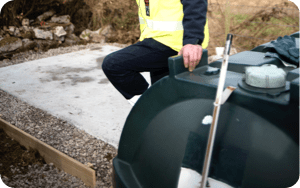It’s always a good idea to keep track of the amount of oil you have left in your heating oil tank. But how can you check the oil level inside your tank? We answer this question and more in our expert guide.
Why you should check your oil gauge regularly
Regular oil level checks help you to estimate the amount of oil you use. And more accurate estimates let you place more accurate orders throughout the year.
Keeping an eye on your oil gauge will make it far less likely for you to run out of oil unexpectedly. You’ll also avoid the risk of overfilling your tank.
Overall, using a home heating oil tank level indicator will save you money. If you know your usage levels, you can plan heating oil deliveries when fuel prices are at their lowest.
Ways of checking your home heating oil level
There are a range of different tools for examining the oil levels in your tank. Oil gauges can be manual or digital and come in various shapes and sizes. Some tanks even come with a pre-fitted gauge.
Pre-fitted oil level monitors usually look like a clear tube on the outside of your tank, allowing you to check the oil level by sight. However, these sight gauges tend to discolour, which can make it difficult to read. Most people use a separate gauge or monitor to get a more accurate reading.
If you’re unsure of what type of gauge you need, consider the following:
Types of heating oil tank gauges and monitors
Smart Oil Monitors
The easiest way to track your oil usage is to use a digital heating oil tank level monitor.
Typical prices start from around £6 a month and smart monitors do require some investment. However, these oil monitors offer built-in safety alerts, so you can save a significant amount of money in the long run.
Mechanical Float Gauge
A cheaper, more manual alternative to a smart monitor is a mechanical float gauge. This type of monitor includes a small floating container that attaches to a gauge. Simply screw the gauge to the top of your tank and the floating device inside will measure how much oil is left in your tank.
Whilst float gauges have been commonplace for many years, they do have some downsides. This method of tracking your heating oil usage lacks any emergency alerts. What’s more, you will need to keep track of your oil usage manually, by taking regular readings.
Using a mechanical float gauge won’t give an exact literage. Instead, the dial will show how full your tank is: ¼ full, ½ full, ¾ full and so on.
Compared to a smart oil meter, mechanical float gauges are cheap and easy to use. But, to track your heating oil usage accurately, you’ll need a digital device.
Dipstick for Home Heating Oil
The old-school way of measuring the amount of oil left in your tank is to use a long straight piece of wood, also called a ‘dipstick’ or ‘gauge stick’.
Similar to checking the oil in a car, simply insert the stick through the tank’s fill valve and lower it until it touches the bottom of the tank. When you lift the stick out, you’ll see how much of the stick is covered in oil.
With plenty of other easy, more accurate alternatives on the market today, the gauge stick mainly comes in handy when nothing else is available. You might need to rely on a dipstick if, for example, your float gauge or digital monitor is broken.
If you are thinking about installing an oil tank in your home, or you want to update an older tank, consider how you will monitor your heating oil levels. The approach you choose may impact the type of tank you need to buy.
Browse our range of heating oil tanks to help with your decision.
When should I get a heating oil refill?
It’s best to order a refill when your gauge indicates that your tank is less than a quarter full.
You should be able to assess how full your tank is, roughly, using any of the methods we’ve described.
Figuring out when to order more heating oil will depend on your oil usage rate. By tracking how much oil you use, you should be able to estimate almost exactly when you will need a delivery.
TOP TIP WHEN TRACKING OIL LEVELS:
Remember: the season will affect how quickly you use up the oil in your tank, as well as how quickly your supplier can deliver a refill. Be especially careful to track your heating oil usage in the lead up to winter. Refill earlier than you might expect (when your tank is perhaps half full) to avoid any cold winter nights!
Speak to a member of our team on 0345 600 4040 for more information on heating oil gauges.





